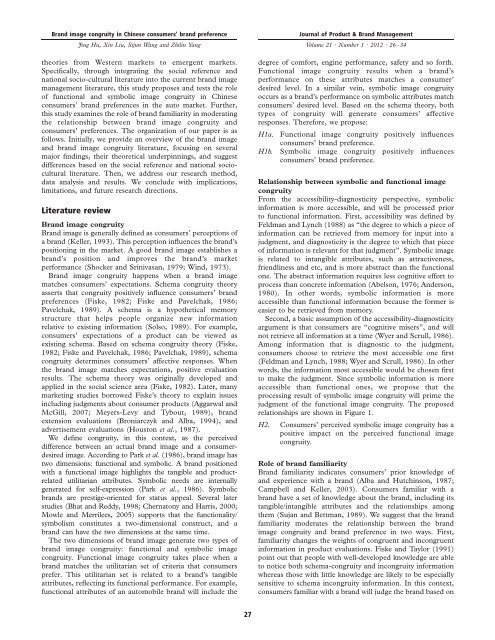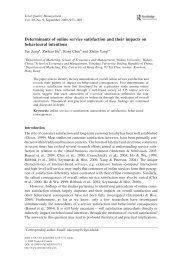The role of brand image congruity in Chinese consumers ... - Emerald
The role of brand image congruity in Chinese consumers ... - Emerald
The role of brand image congruity in Chinese consumers ... - Emerald
Create successful ePaper yourself
Turn your PDF publications into a flip-book with our unique Google optimized e-Paper software.
Brand <strong>image</strong> <strong>congruity</strong> <strong>in</strong> Ch<strong>in</strong>ese <strong>consumers</strong>’ <strong>brand</strong> preference<br />
J<strong>in</strong>g Hu, X<strong>in</strong> Liu, Sijun Wang and Zhil<strong>in</strong> Yang<br />
theories from Western markets to emergent markets.<br />
Specifically, through <strong>in</strong>tegrat<strong>in</strong>g the social reference and<br />
national socio-cultural literature <strong>in</strong>to the current <strong>brand</strong> <strong>image</strong><br />
management literature, this study proposes and tests the <strong>role</strong><br />
<strong>of</strong> functional and symbolic <strong>image</strong> <strong>congruity</strong> <strong>in</strong> Ch<strong>in</strong>ese<br />
<strong>consumers</strong>’ <strong>brand</strong> preferences <strong>in</strong> the auto market. Further,<br />
this study exam<strong>in</strong>es the <strong>role</strong> <strong>of</strong> <strong>brand</strong> familiarity <strong>in</strong> moderat<strong>in</strong>g<br />
the relationship between <strong>brand</strong> <strong>image</strong> <strong>congruity</strong> and<br />
<strong>consumers</strong>’ preferences. <strong>The</strong> organization <strong>of</strong> our paper is as<br />
follows. Initially, we provide an overview <strong>of</strong> the <strong>brand</strong> <strong>image</strong><br />
and <strong>brand</strong> <strong>image</strong> <strong>congruity</strong> literature, focus<strong>in</strong>g on several<br />
major f<strong>in</strong>d<strong>in</strong>gs, their theoretical underp<strong>in</strong>n<strong>in</strong>gs, and suggest<br />
differences based on the social reference and national sociocultural<br />
literature. <strong>The</strong>n, we address our research method,<br />
data analysis and results. We conclude with implications,<br />
limitations, and future research directions.<br />
Literature review<br />
Brand <strong>image</strong> <strong>congruity</strong><br />
Brand <strong>image</strong> is generally def<strong>in</strong>ed as <strong>consumers</strong>’ perceptions <strong>of</strong><br />
a <strong>brand</strong> (Keller, 1993). This perception <strong>in</strong>fluences the <strong>brand</strong>’s<br />
position<strong>in</strong>g <strong>in</strong> the market. A good <strong>brand</strong> <strong>image</strong> establishes a<br />
<strong>brand</strong>’s position and improves the <strong>brand</strong>’s market<br />
performance (Shocker and Sr<strong>in</strong>ivasan, 1979; W<strong>in</strong>d, 1973).<br />
Brand <strong>image</strong> <strong>congruity</strong> happens when a <strong>brand</strong> <strong>image</strong><br />
matches <strong>consumers</strong>’ expectations. Schema <strong>congruity</strong> theory<br />
asserts that <strong>congruity</strong> positively <strong>in</strong>fluence <strong>consumers</strong>’ <strong>brand</strong><br />
preferences (Fiske, 1982; Fiske and Pavelchak, 1986;<br />
Pavelchak, 1989). A schema is a hypothetical memory<br />
structure that helps people organize new <strong>in</strong>formation<br />
relative to exist<strong>in</strong>g <strong>in</strong>formation (Solso, 1989). For example,<br />
<strong>consumers</strong>’ expectations <strong>of</strong> a product can be viewed as<br />
exist<strong>in</strong>g schema. Based on schema <strong>congruity</strong> theory (Fiske,<br />
1982; Fiske and Pavelchak, 1986; Pavelchak, 1989), schema<br />
<strong>congruity</strong> determ<strong>in</strong>es <strong>consumers</strong>’ affective responses. When<br />
the <strong>brand</strong> <strong>image</strong> matches expectations, positive evaluation<br />
results. <strong>The</strong> schema theory was orig<strong>in</strong>ally developed and<br />
applied <strong>in</strong> the social science area (Fiske, 1982). Later, many<br />
market<strong>in</strong>g studies borrowed Fiske’s theory to expla<strong>in</strong> issues<br />
<strong>in</strong>clud<strong>in</strong>g judgments about consumer products (Aggarwal and<br />
McGill, 2007; Meyers-Levy and Tybout, 1989), <strong>brand</strong><br />
extension evaluations (Broniarczyk and Alba, 1994), and<br />
advertisement evaluations (Houston et al., 1987).<br />
We def<strong>in</strong>e <strong>congruity</strong>, <strong>in</strong> this context, as the perceived<br />
difference between an actual <strong>brand</strong> <strong>image</strong> and a consumerdesired<br />
<strong>image</strong>. Accord<strong>in</strong>g to Park et al. (1986), <strong>brand</strong> <strong>image</strong> has<br />
two dimensions: functional and symbolic. A <strong>brand</strong> positioned<br />
with a functional <strong>image</strong> highlights the tangible and productrelated<br />
utilitarian attributes. Symbolic needs are <strong>in</strong>ternally<br />
generated for self-expression (Park et al., 1986). Symbolic<br />
<strong>brand</strong>s are prestige-oriented for status appeal. Several later<br />
studies (Bhat and Reddy, 1998; Chernatony and Harris, 2000;<br />
Mowle and Merrilees, 2005) supports that the functionality/<br />
symbolism constitutes a two-dimensional construct, and a<br />
<strong>brand</strong> can have the two dimensions at the same time.<br />
<strong>The</strong> two dimensions <strong>of</strong> <strong>brand</strong> <strong>image</strong> generate two types <strong>of</strong><br />
<strong>brand</strong> <strong>image</strong> <strong>congruity</strong>: functional and symbolic <strong>image</strong><br />
<strong>congruity</strong>. Functional <strong>image</strong> <strong>congruity</strong> takes place when a<br />
<strong>brand</strong> matches the utilitarian set <strong>of</strong> criteria that <strong>consumers</strong><br />
prefer. This utilitarian set is related to a <strong>brand</strong>’s tangible<br />
attributes, reflect<strong>in</strong>g its functional performance. For example,<br />
functional attributes <strong>of</strong> an automobile <strong>brand</strong> will <strong>in</strong>clude the<br />
Journal <strong>of</strong> Product & Brand Management<br />
Volume 21 · Number 1 · 2012 · 26–34<br />
degree <strong>of</strong> comfort, eng<strong>in</strong>e performance, safety and so forth.<br />
Functional <strong>image</strong> <strong>congruity</strong> results when a <strong>brand</strong>’s<br />
performance on these attributes matches a consumer’<br />
desired level. In a similar ve<strong>in</strong>, symbolic <strong>image</strong> <strong>congruity</strong><br />
occurs as a <strong>brand</strong>’s performance on symbolic attributes match<br />
<strong>consumers</strong>’ desired level. Based on the schema theory, both<br />
types <strong>of</strong> <strong>congruity</strong> will generate <strong>consumers</strong>’ affective<br />
responses. <strong>The</strong>refore, we propose:<br />
H1a. Functional <strong>image</strong> <strong>congruity</strong> positively <strong>in</strong>fluences<br />
<strong>consumers</strong>’ <strong>brand</strong> preference.<br />
H1b. Symbolic <strong>image</strong> <strong>congruity</strong> positively <strong>in</strong>fluences<br />
<strong>consumers</strong>’ <strong>brand</strong> preference.<br />
Relationship between symbolic and functional <strong>image</strong><br />
<strong>congruity</strong><br />
From the accessibility-diagnosticity perspective, symbolic<br />
<strong>in</strong>formation is more accessible, and will be processed prior<br />
to functional <strong>in</strong>formation. First, accessibility was def<strong>in</strong>ed by<br />
Feldman and Lynch (1988) as “the degree to which a piece <strong>of</strong><br />
<strong>in</strong>formation can be retrieved from memory for <strong>in</strong>put <strong>in</strong>to a<br />
judgment, and diagnosticity is the degree to which that piece<br />
<strong>of</strong> <strong>in</strong>formation is relevant for that judgment”. Symbolic <strong>image</strong><br />
is related to <strong>in</strong>tangible attributes, such as attractiveness,<br />
friendl<strong>in</strong>ess and etc, and is more abstract than the functional<br />
one. <strong>The</strong> abstract <strong>in</strong>formation requires less cognitive effort to<br />
process than concrete <strong>in</strong>formation (Abelson, 1976; Anderson,<br />
1980). In other words, symbolic <strong>in</strong>formation is more<br />
accessible than functional <strong>in</strong>formation because the former is<br />
easier to be retrieved from memory.<br />
Second, a basic assumption <strong>of</strong> the accessibility-diagnosticity<br />
argument is that <strong>consumers</strong> are “cognitive misers”, and will<br />
not retrieve all <strong>in</strong>formation at a time (Wyer and Scrull, 1986).<br />
Among <strong>in</strong>formation that is diagnostic to the judgment,<br />
<strong>consumers</strong> choose to retrieve the most accessible one first<br />
(Feldman and Lynch, 1988; Wyer and Scrull, 1986). In other<br />
words, the <strong>in</strong>formation most accessible would be chosen first<br />
to make the judgment. S<strong>in</strong>ce symbolic <strong>in</strong>formation is more<br />
accessible than functional ones, we propose that the<br />
process<strong>in</strong>g result <strong>of</strong> symbolic <strong>image</strong> <strong>congruity</strong> will prime the<br />
judgment <strong>of</strong> the functional <strong>image</strong> <strong>congruity</strong>. <strong>The</strong> proposed<br />
relationships are shown <strong>in</strong> Figure 1.<br />
H2. Consumers’ perceived symbolic <strong>image</strong> <strong>congruity</strong> has a<br />
positive impact on the perceived functional <strong>image</strong><br />
<strong>congruity</strong>.<br />
Role <strong>of</strong> <strong>brand</strong> familiarity<br />
Brand familiarity <strong>in</strong>dicates <strong>consumers</strong>’ prior knowledge <strong>of</strong><br />
and experience with a <strong>brand</strong> (Alba and Hutch<strong>in</strong>son, 1987;<br />
Campbell and Keller, 2003). Consumers familiar with a<br />
<strong>brand</strong> have a set <strong>of</strong> knowledge about the <strong>brand</strong>, <strong>in</strong>clud<strong>in</strong>g its<br />
tangible/<strong>in</strong>tangible attributes and the relationships among<br />
them (Sujan and Bettman, 1989). We suggest that the <strong>brand</strong><br />
familiarity moderates the relationship between the <strong>brand</strong><br />
<strong>image</strong> <strong>congruity</strong> and <strong>brand</strong> preference <strong>in</strong> two ways. First,<br />
familiarity changes the weights <strong>of</strong> congruent and <strong>in</strong>congruent<br />
<strong>in</strong>formation <strong>in</strong> product evaluations. Fiske and Taylor (1991)<br />
po<strong>in</strong>t out that people with well-developed knowledge are able<br />
to notice both schema-<strong>congruity</strong> and <strong>in</strong><strong>congruity</strong> <strong>in</strong>formation<br />
whereas those with little knowledge are likely to be especially<br />
sensitive to schema <strong>in</strong><strong>congruity</strong> <strong>in</strong>formation. In this context,<br />
<strong>consumers</strong> familiar with a <strong>brand</strong> will judge the <strong>brand</strong> based on<br />
27



